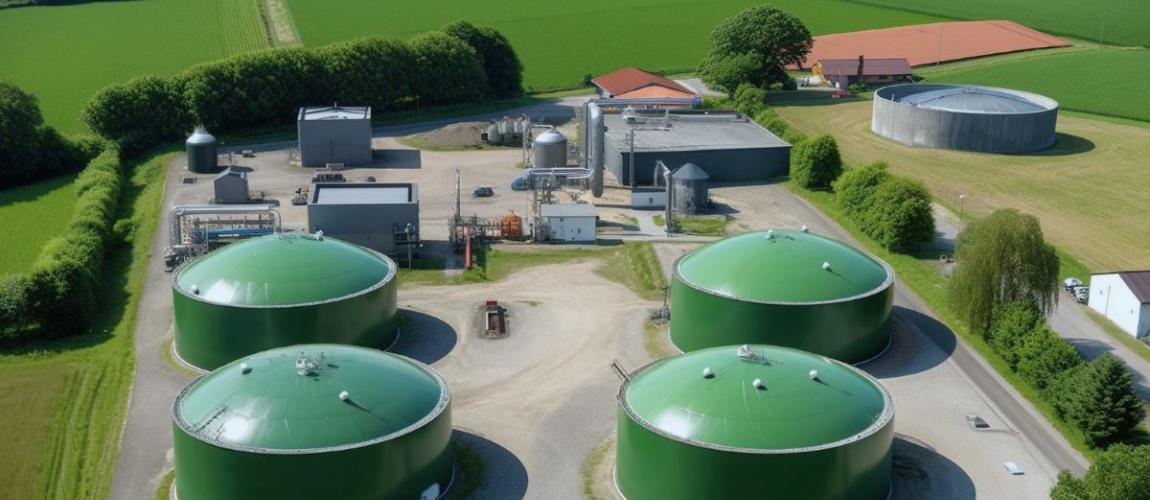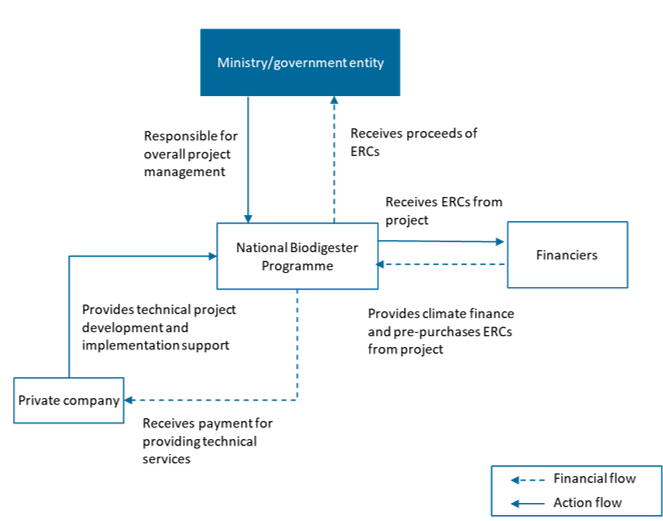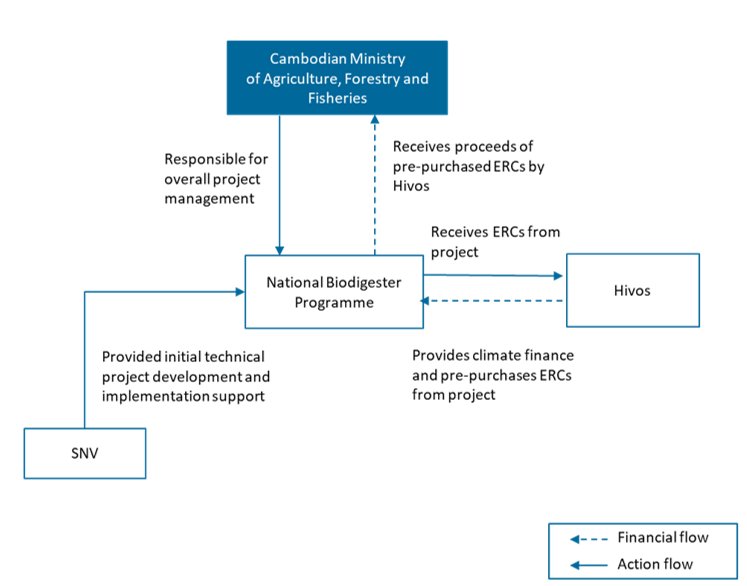Biodigesters Deployment Model for ERP

Photo Credit: Image by Freepik
On this page: Biodigesters Deployment leveraging a New-Build-Finance-User-Fees model - Model 8 in the ERP Project Guidelines. Read more below, or visit Strategic Guidance for Country System Assessments, Guidance for Countries in Assessing ERC Projects, or Mobilizing ERC Finance.
Project Type: Household device
Sector: Energy - Households
Applicable Project Methodology: Reduced Emissions from Cooking and Heating – Technologies and Practices to Displace Decentralized Thermal Energy Consumption
This model describes a project that aims to install and promote the use of biodigesters across households that have access to livestock bio-waste and would otherwise be using wood taken from nearby forests as the energy source for cooking. Aside from transitioning households to cleaner energy alternatives for cooking, installing biodigesters is expected to enhance agricultural productivity through the bio-slurry produced, and potentially reduce deforestation.
The project will be leveraging a New-Build-Finance-User-Fees model. Given the nascent nature of such biodigesters for this geography and the reliance of the model on carbon financing, the government or state-owned entity may be best placed to support a private company with the appropriate experience to take on the core obligations in this model. The private-sector entity in this model designs, partly finances and installs the biodigesters across the target households. This company will also be tasked with owning the continuous operation of the project, to support households with the new biodigesters for their continued use. Table 1: Model Attributes Business New The model involves the creation of a new business entity to manage and operate the new transmissions infrastructure Existing Construction Build The model involves the creation of a new business entity to orchestrate the deployment and support the continued use of the biodigesters Refurbish Private Funding Finance The model involves installing the biodigesters across the target households Service Bulk The resulting project company in the model will be installing the biodigesters across the user households User Revenues Fees Majority of revenues in this model will be sourced from the upfront fees paid by the households through supported micro-loans to install the biodigester; the rest will be sourced from carbon financing. Proposed risk allocation of the Public Private Partnership Model Key features of PPP structure Expected ERC end use Key considerations/risks for proposed project Figure 1: Financing and Activity Flows for the Model Project description The Cambodian National Biodigester Programme (NBP), set up in 2006 by the Ministry of Agriculture, Forestry and Fisheries (MAFF) and SNV Netherlands Development Organization, has constructed nearly 29,000 biodigesters through 118 micro-enterprises in 15 provinces. It aims to develop a market-oriented biodigester sector in Cambodia to promote biogas use and reduce deforestation, while improving agricultural yields through bio-slurry, and enabling rural households to switch to clean cooking from wood. The programme was one of the first large-scale biogas projects certified by Gold Standard. Starting in 2017, MAFF has been utilizing funds generated from the sale of carbon credits to sustain and broaden the scope of this program. The private sector development arm of NBP is establishes independent enterprises in rural areas and builds capacity of these enterprises on marketing and promotion, internal quality control and after sales services Targeted results Expected annual ERCs generated from the program will be 78,699 tonnes. Figure 2: Structure of Case Study PPP SNV, a Dutch non-governmental organization (NGO), signed an agreement with the Cambodian MAFF to create the NBP. Hivos, another Dutch NGO, joined the consortium in 2007, offering carbon finance. SNV representatives have a set term to start the initiative, with an "expiration date" built-in to ensure local ownership which means fully transferring complete operations of the program to MAFF once its term has ended. Hivos International also entered an Emissions Reduction Purchase Agreement in this program with Hivos committing to purchasing the ERCs at a predetermined price. The project’s Net Present Value (NPV) without ERC in- and outflows is negative at - $2.43 million (M)1. With ERC cashflows, the NPV becomes less negative at -$1.3M. This is as the project has a high upfront investment cost and implementation cost but the project owner – in this case, the government or state-owned entity – does not generate additional revenues or cost savings through the project other than revenues from selling ERCs, and hence requires additional funding from financiers. On the other hand, the NPV of users from the inflows provided by cost savings and co-benefits from the biodigesters net of the outflows from the cost of the biodigesters provided by micro-loans is relatively high at $4.17M, which demonstrates the need for such household device projects to generate ERCs to enable financial viability for the project owners to take on the project and unlock benefits to end-users who otherwise would not have been able to afford such devices. Table 2: Summary of sources of inflows and outflows and key assumptions ERC revenues or inflows Average Gold Standard (GS) price of household device project in Asia from Allied Offsets database (2022) User benefit inflows from cost savings Intermediary selling case study’s ERCs, Skoot; estimated economic co-benefits from biodigesters by Hyman & Bailis (2018) Investment cost Breakdown of cumulative NBP expenditure by Hyman & Bailis (2018) Project implementation Breakdown of cumulative NBP expenditure by Hyman & Bailis (2018) ERC generation Breakdown of cumulative NBP expenditure by Hyman & Bailis (2018) User benefit outflows from cost of biodigesters for household users Cost of biodigester by Hyman & Bailis (2018) Table 3: Net cashflows summary (in USD) ERC Component Revenues/Inflows 0 5,495,178 5,495,178 Costs/Outflows 0 -250,833 -250,833 Net value 0 5,244,344 5,244,344 Primary/Non-ERC Component Revenues/Inflows 0 0 0 Costs/Outflows -1,290,000 -6,414,167 -7,704,167 Net value -1,290,000 -6,414,167 -7,704,167 Total Net Value NPV -$1,299,195 NPV (ERC Component) $1,130,490 NPV (Non-ERC Component) -$2,429,685 NPV (Net user benefit) $4,172,596 Footnote 1: All prices are expressed in United States Dollars (USD)Proposed Structure of this Public Private Partnership (PPP) Model
Dimension
Attribute
Description


Case study: National Biodigester Programme, Cambodia

Summary of the model financials
Value component
Assumptions
Sources
Components
Sum of initial outlays
Sum of in- or outflows from crediting period
Total cashflow
This section is intended to be a living document and will be reviewed at regular intervals. The Guidelines have not been prepared with any specific transaction in mind and are meant to serve only as general guidance. It is therefore critical that the Guidelines be reviewed and adapted for specific transactions. Unless expressly stated otherwise, the findings, interpretations, and conclusions expressed in the Materials in this Site are those of the various authors of the Materials and are not necessarily those of The World Bank Group, its member institutions, or their respective Boards of Executive Directors or member countries. For feedback on the content of this section of the website or suggestions for links or materials that could be included, please contact the PPPLRC at ppp@worldbank.org.
Updated: June 4, 2024
TABLE OF CONTENTS
UNLOCKING GLOBAL EMISSION REDUCTION CREDIT
Guidance for Countries in Assessing ERC Projects
1. Introduction to Emission Reduction Credits
• The World Bank's Emission Reduction Program
•Classification of Emissions Reduction Credit
• Policy Context of Emissions Reduction Credit
2. Objective of the Guidance for Countries in Assessing ERC Projects
• Objective of Project Preparation Guidelines
• Introduction to the Project Assessment Framework
• Process to Conducting Assessments
• S1: Green Economy Priorities
• S3: Article 6 Readiness and Eligibility
4. Conducting the Initial Profiling and Making a Preliminary Decision
• F2: Additional Value Enabled by Project
• C1, C2, and C3: Carbon Integrity and Environmental and Social Risk Management
5. Conducting the Project Assessment and Making the Final Decision
• F1: Project ERC value and F2: Additional Value Enabled by Project
• Q2: Marketing, Sales, and Pricing
• Q3: Project Governance and Structure
• C2: Environmental Risk Management
• C3: Social Risk Management and Benefits
6. Further Guidance for Application
• Country Context-driven Factors
• Considerations for Future Scope
Abbreviations: Guidance for Countries in Assessing ERC Projects
• B: Project Assessment Template
- Model 1: MRT Energy Efficiencies Model for ERP
- Model 2: Rural Electrification Model for ERP
- Model 4: Rooftop Solar Installation Model for ERP
- Model 5: LED Streetlight Deployment Model for ERP - for Specific Technologies
- Model 6: E-bus Deployment Model for ERP
- Model 7: EV Charging Systems Installation Model for ERP
- Model 8: Biodigesters Deployment Model for ERP
- Model 9: Waste-to-Power Model for ERP
- Model 10: Waste Treatment Facility Model for ERP
- Model 11: Climate Smart Farming Deployment Model for ERP
- Model 12: Reforestation Program Model for ERP